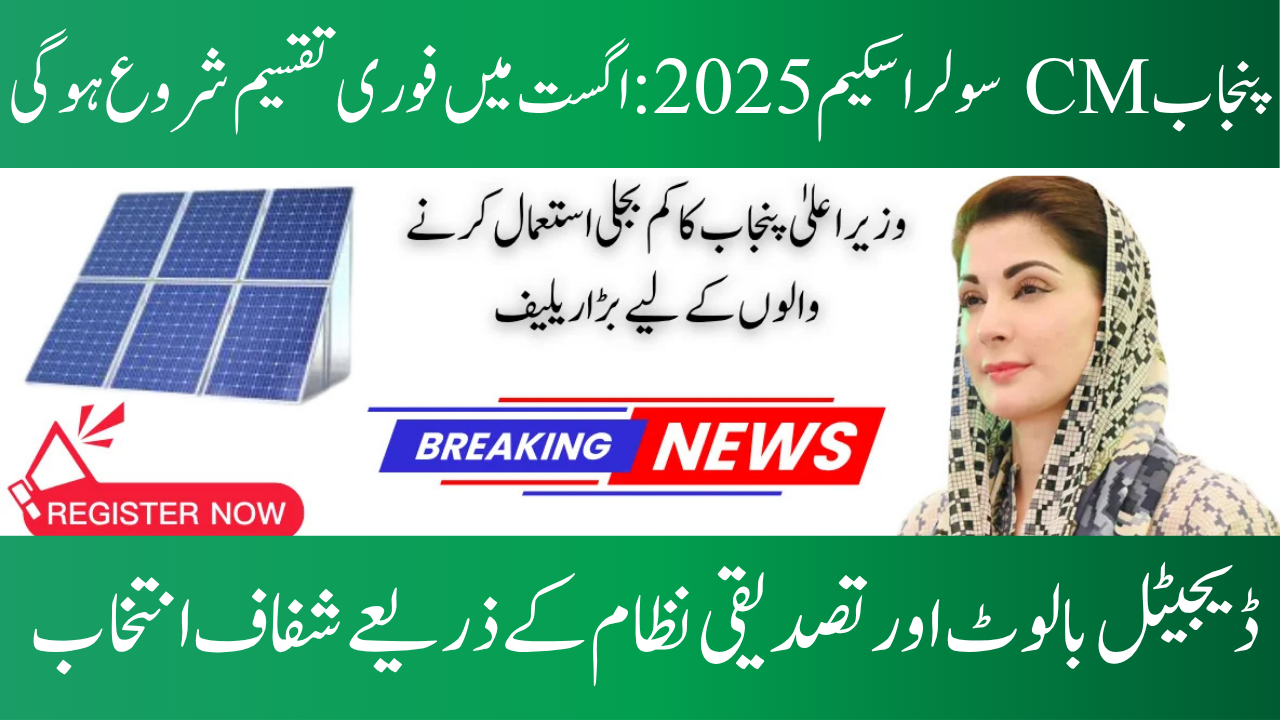Punjab CM Solar Scheme 2025
In 2025, the Punjab Chief Minister’s Solar Panel Scheme, launched under the leadership of Maryam Nawaz Sharif, marks a major milestone in the province’s move toward clean energy and economic relief. Aimed at reducing electricity costs for low- and moderate-income households, this initiative provides fully funded and highly subsidized solar systems across Punjab. With installations set to begin in August 2025, this article explains the program’s features, eligibility criteria, district-wise distribution plan, and the impact on Punjab’s energy landscape.
You can also read: BISP 8171 Expansion August 2025 – New Districts & Full Eligibility Guide
What the Scheme Offers
The CM Punjab Solar Panel Scheme is designed to ease the pressure of rising energy costs while advancing renewable energy use. The government has structured the scheme to serve two major consumer segments:
| Electricity Usage | Benefit |
|---|---|
| Up to 200 units/month | Free solar system (0.55 kW or 1.1 kW) |
| 200–500 units/month | 90% subsidy; 10% cost borne by consumer over five years |
Each solar system includes a photovoltaic Solar Panel and an inverter, with technical specifications suited for basic household electricity needs. On average, beneficiaries are expected to see a 40% reduction in their monthly bills. This translates not only into household savings but also helps reduce overall demand on the provincial grid.
Installations are set to begin in August, following a detailed verification and balloting process that concluded in June 2025.
Eligibility Criteria: Who Can Apply?
To be eligible:
-
Applicants must have a residence in Punjab.
-
Electricity consumption must be
-
Up to 200 units/month for the free Solar Panel system.
-
-
A valid CNIC, recent electricity bill, and meter reference number are required during registration.
-
Only one solar system per household is allowed.
-
Households already benefiting from other government Solar Panel initiatives or subsidies may be excluded to ensure fair distribution.
The government encourages only genuinely eligible applicants to register, as physical verification is mandatory before system installation.
You can also read: In some districts, BISP Eligibility Check by Mobile Van and Withdrawal Payment
Balloting and Selection Process
The response to the program has been overwhelming. By mid-2025, over 861,000 applications had been submitted through online and in-person channels. To ensure transparency and fairness, a digital balloting system was used to randomly select the initial group of beneficiaries.
Approximately 100,000 solar panel systems will be distributed in the first phase. Of these, about 94,483 are confirmed for installation during the initial rollout, subject to successful verification. Each selected household is notified and scheduled for a home visit to confirm eligibility and prepare for installation.

District-Wise Distribution Timeline
The installations will be carried out in phases, beginning August 14, 2025, coinciding with Pakistan’s Independence Day. The phased schedule will roll out across districts in three stages:
-
Phase 1 (August–September): Lahore, Faisalabad, Multan, and other central districts.
-
Phase 2 (September–October): Southern and western districts, including Bahawalpur, Dera Ghazi Khan, and Sargodha.
-
Phase 3 (October–November): Northern and border areas such as Rawalpindi, Gujrat, and Sialkot.
Installation and Payment Mechanism
The scheme follows a simple and structured approach to installation and payments:
-
Free Systems (≤200 units/month): The provincial government bears the full cost, including hardware, installation, and maintenance.
-
Subsidized Systems (200–500 units/month): Consumers pay just 10% of the total cost. This amount is spread over five years with zero interest, and payments are collected through partner banks.
Each solar panel system is digitally linked to the recipient’s CNIC. This linkage prevents misuse, ensures traceability, and facilitates secure tracking by government and banking partners.
Once physical verification is complete, installation teams will contact the selected households to schedule the system setup. Applicants will receive messages and notifications regarding delivery timelines, technical specifications, and payment schedules (if applicable).
You can also read: Reopening in July 2025, the BISP 8171 Portal will have updated features for checking 13500 and registering
Broader Impact on Energy and Economy
The CM Punjab Solar Panel Scheme is not merely a financial relief package it is a strategic move toward sustainable development. Key expected impacts include:
-
Financial Relief: By replacing grid electricity with solar, households can reduce monthly bills by 30–50%, depending on usage and system size.
-
Environmental Benefits: Lower reliance on fossil fuels reduces carbon emissions and supports Pakistan’s international climate goals.
-
Energy Independence: Encouraging distributed solar generation reduces pressure on the national grid and minimizes outages during peak demand periods.
-
Economic Participation: The scheme promotes local employment through solar panel manufacturing, installation, and maintenance services.
Punjab has lagged behind other provinces in solar energy deployment, but this initiative positions it to catch up by focusing on affordability and widespread access.
Conclusion
If you live in Punjab and meet the electricity usage criteria, this is the time to take action. Whether you’re eligible for a free solar system or the subsidized version, ensure your application includes correct details and supporting documents. If you’ve already registered, monitor your application status and await verification instructions.
With implementation beginning in August 2025 and continuing through the end of the year, this scheme represents a transformative step for Punjab. It delivers financial relief, promotes clean energy, and empowers communities with long-term solutions to electricity access and affordability.
By participating in this Solar Panel program, households are not only saving money—they are becoming part of a broader movement toward sustainable living.
You can also read: BISP 8171 July 2025 Eligibility for Payment 36000
FAQs
1. Who qualifies for a free solar panel system?
Households in Punjab with a monthly electricity consumption of up to 200 units qualify for a fully free solar system. Selection is based on digital balloting and successful physical verification.
2. What is the cost structure for subsidized users?
Consumers using 200–500 units per month will receive a 90% government subsidy. They only pay 10% of the cost, distributed over five years through an interest-free installment plan.
3. When does the distribution start, and how will it progress?
Installations begin on August 14, 2025, and proceed in phases through November. Central districts are prioritized in Phase 1, followed by southern and northern districts.
4. How were households selected for the first phase?
Out of 861,000 applicants, a digital balloting process was used to randomly select the first 100,000 households. These applicants are undergoing physical verification before receiving their systems.
5. Are solar systems connected to national ID records?
Yes. Each system is digitally linked to the recipient’s CNIC to ensure accuracy, prevent fraud, and streamline management.

good